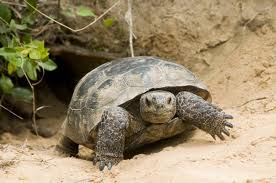
by Rick O'Connor | Jun 22, 2018
Just a decade ago, few people would have known what a gopher tortoise was and would have hard time finding one. But today, because of the protection they have been afforded by the state, they are becoming more common. This is certainly an animal you might see visiting one of our state parks.
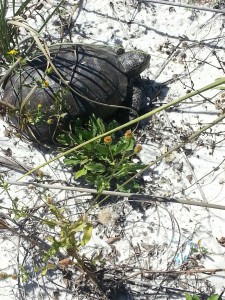
This gopher tortoise was found in the dune fields on a barrier island – an area where they were once found.
Photo: DJ Zemenick
The gopher tortoise is one of only two true land dwelling turtles in our area and is in a family all to its own. They are miners, digging large burrows that can extend up to a depth of 7 feet and a length of 15 feet underground. However, tortoises are not very good at digging up towards the surface, so there is only the one entrance in and out of the burrow. The burrow of the tortoise can be distinguished from other burrowing animals, such as armadillos, in that the bottom line of the opening is flat – a straight line – and the top is domed or arched shaped; mammalian burrows are typically round – circular. Tortoise burrows also possess a layer of dirt tossed in a delta-shaped fan out away from the entrance (called an apron). Many times the soil is from deeper in the ground and has a different color than the soil at the surface. The general rule is one burrow equals one tortoise, though this is not always true. Some burrows are, at times, shared by more than one and some may not be occupied at all. Many field biologists will multiple the number of burrows by 0.6 to get an estimate of how many tortoises there are in the area.
The tortoise itself is rather large, shell lengths reaching 15 inches. They can be distinguished from the other land dwelling turtle, the box turtle, by having a more flattened dome to the shell and large elephant like legs. The forelimbs are more muscular than the hind and possess large claws for digging the burrow. They are much larger than box turtles and do not have hinged plastrons (the shell covering the chest area) and cannot close themselves up within the shell as box turtles can. Tortoises prefer dry sandy soils in areas where it is more open and there are plenty of young plants to eat; box turtles are fans of more dense brush and wooded areas.
Tortoises spend most of the day within their burrows – which remain in the 70°F range. Usually when it is cooler, early morning or late afternoon, or during a rain event – the tortoises will emerge and feed on young plants. You can see the paths they take from their burrows on foraging trips. They feed on different types of plants during different type times of the year to obtain the specific nutrients. There are few predators who can get through the tough shell, but they do have some and so do not remain out for very long. Most people find their burrows, and not the tortoise. You can tell if the burrow has an active tortoise within by the tracks and scrap marks at the entrance. Active burrows are “clean” and not overgrown with weeds and debris. Many times, you can see the face of the tortoise at the entrance, but once they detect you – they will retreat further down. Many times a photo shot within a burrow will reveal the face of a tortoise in the picture. There is a warning here though. Over 370 species of creatures use this burrow to get out of the weather along with the tortoise – one of them is the diamondback rattlesnake. So do not stick your hand or your face into the entrance seeking a tortoise.
Most of the creatures sharing the burrow are insects but there are others such as the gopher frog and the gopher mouse. One interesting member of the burrow family is the Eastern Indigo Snake. This is the largest native snake to North America, reaching a length of eight feet, and is a beautiful iridescent black color. It is often confused with the Southern Black Racer. However, the black racer is not as long, not as large around (girth), and possess a white lower jaw instead of the red-orange colored one of the indigo. The indigo is not dangerous at all, actually it feeds on venomous snakes and it is a good one to have around.
Federal and state laws protect the indigo, as with the gopher frog and mouse. All of these animals have declined in number over the past few decades. This is primarily due to loss of the needed gopher burrows, which have declined because the tortoises have declined, and this is due to habitat loss and harvesting. Again, tortoises like dry sandy soils for digging burrows. They prefer wooded areas that are more open and allow the sun to reach the forest floor where young grasses and flowers can grow. The longleaf pine forest is historically the place to find them but they are found in coastal areas where such open wooded areas exist. The lack of prescribe burning has been a problem for them. Florida is the number one state for lightning strikes. Historically, lightning strikes would occasionally start fires, which would burn the underbrush and allow grasses to grow. In recent years, humans have suppressed such fires, for obvious reasons, and the tortoise community has suffered because of it. Therefore, we now have prescribe fire programs on most public lands in the area. This has helped to increase the number of tortoises in the area and your chance of seeing one.
All of the members of the tortoise community are still protected by state, and – in the case of the indigo snake – federal law, so you must not disturb them if seen. Photos are great and you should feel lucky to have viewed one. Though they could be found anywhere where it is high, dry, and somewhat open – the state and national parks are good places to look.
Reference
Meylan, P.A. (Ed.). 2006. Biology and Conservation of Florida Turtles. Chelonian Research Monographs No. 3, 376 pp.
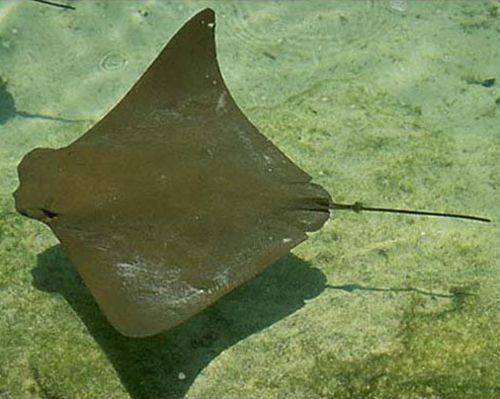
by Rick O'Connor | May 31, 2018
It is now late May and in recent weeks I, and several volunteers, have been surveying the area for terrapins, horseshoe crabs, and monitoring local seagrass beds. We see many creatures when we are out and about; one that has been quite common all over the bay has been the “stingray”.
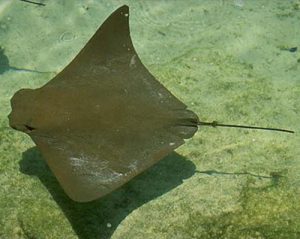
The cownose ray is often mistaken for the manta ray. It lacks the palps (“horns”) found on the manta.
Photo: Florida Sea Grant
These are intimidating creatures… everyone knows how they can inflict a painful wound using the spine in their tail, but may are not aware that not all “stingrays” can actually use a spine to drive you off – actually, not all “rays” are “stingrays”.
So what is a ray?
First, they are fish – but differ from most fish in that they lack a bony skeleton. Rather it is cartilaginous, which makes them close cousins of the sharks.
So what is the difference between a shark and a ray?
You would immediately jump on the fact that rays are flat disked-shape fish, and that sharks are more tube-shaped and fish like. This is probably true in most cases, but not all. The characteristics that separate the two groups are
- The five gill slits of a shark are on the side of the head – they are on the ventral side (underside) of a ray
- The pectoral fin begins behind the gill slits in sharks, in front of for the ray group
Not all rays have the whip-like tail that possess a sharp spine; some in fact have a tube-shaped body with a well-developed caudal fin for a tail.
There are eight families and 19 species of rays found in the Gulf of Mexico. Some are not common, but others are very much so.
Sawfish are large tube-shaped rays with a well-developed caudal fin. They are easily recognized by their large rostrum possessing “teeth” giving them their common name. Walking the halls of Sacred Heart Hospital in Pensacola, you will see photos of fishermen posing next to monsters they have captured. Sawfish can reach lengths of 18 feet… truly intimidating. However, they are very slow and lethargic fish. They spend their lives in estuaries, rarely going deeper than 30 feet. They were easy targets for fishermen who displayed them as if they caught a true monster. Today they are difficult to find and are protected. There are still sightings in southwest Florida, and reports from our area, but I have never seen one here. I sure hope to one day. There are two species in the Gulf of Mexico.
Guitarfish are tube-shaped rays that are very elongated. They appear to be sharks, albeit their heads are pretty flat. They more common in the Gulf than the bay and, at times, will congregate near our reefs and fishing piers to breed. They are often confused with the electric rays called torpedo rays, but guitarfish lack the organs needed to deliver an electric shock. They have rounded teeth and prefer crustaceans and mollusk to fish. There is only one species in the Gulf.
Torpedo rays can deliver an electric shock – about 35 volts of one. Though there are stories of these shocking folks to death, I am not aware of any fatalities. Nonetheless, the shock can be serious and beach goers are warned to be cautious. I once mistook one buried in the sand for a shell. Let us just say the jolt got my attention and I may have had a few words for this fish before I returned to the beach. We have two species of torpedo rays in the Gulf of Mexico.
Skates look JUST like stingrays – but they lack the whip-like tail and the venomous spine that goes with it. They are very common in the inshore waters of the Florida Panhandle and though they lack the terrifying spine we are all concerned about, they do possess a series of small thorn-like spine on the back that can be painful to the bare foot of a swimmer. Skates are famous for producing the black egg case folks call the “mermaids’ purse”. These are often found dried up along the shore of both the Gulf and they bay and popular items to take home after a fun day at the beach. There are four species of skates found in the Gulf of Mexico.
Stingrays… this is the one… this is the one we are concerned about. Stingrays can be found on both sides of our barrier islands and like to hide beneath the sand to ambush their prey. More often than not, when we approach they detect this and leave. However, sometimes they will remain in the sand hoping not to be detected. The swimmer then steps on their backs forcing them to whip their long tail over and drive the serrated spine into your foot. This usually makes you move off them – among other things. The piercing is painful and spine (which is actually a modified tooth) possesses glands that contain a toxic substance. It really is no fun to be stung by these guys. Many people will do what is called the “stingray shuffle” as they move through the water. This is basically sliding your feet across the sand reducing your chance of stepping on one. They are no stranger to folks who visit St. Joe Bay. The spines being modified teeth can be easily replaced after lodging in your foot. Actually, it is not uncommon to find one with two or three spines in their tails ready to go. Stingrays do not produce “mermaids’ purses” but rather give live birth. There are five species in the Gulf of Mexico.
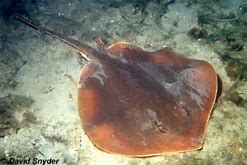
The Atlantic Stingray is one of the common members of the ray group who does possess a venomous spine.
Photo: Florida Museum of Natural History
Butterfly ray is a strange looking fish and easy to recognize. The wide pectoral fins and small tail gives it the appearance of a butterfly. Despite the small tail, it does possess a spine. However, the small tail makes it difficult for the butterfly ray to pierce you with it. There is only one species in the Gulf, the smooth butterfly ray.
Eagle rays are one of the few groups of rays that actually in the middle of the water column instead of sitting on the ocean floor. They can get quite large and often mistaken for manta rays. Eagle rays lack the palps (“horns”) that the manta ray possesses. Rather they have a blunt shaped head and feed on mollusk. They do have venomous spines but, as with the butterfly ray, their tails are too short to extend and use it the way stingrays do. There are two species. The eagle ray is brown and has spots all over its back. The cownose ray is very common and almost every time I see one, I hear “there go manta rays”… again, they are not mantas. They have a habit of swimming in the surf and literally body surfing. Surfers, beachcombers, and fishermen frequently see them.
Last but not least is the very large Manta ray. This large beast can reach 22 feet from wingtip to wing tip. Like eagle rays, they swim through the ocean rather than sit on the bottom. They have to large “horns” (called palps) that help funnel plankton into their mouths. These horns give them one of their common names – the devilfish. Mantas, like eagle and butterfly rays, do have whip-like tails and a venomous spine, but like the above, their tails are much shorter and so effective placement of the spine in your foot is difficult.
Many are concerned when they see rays – thinking that all can inflict a painful spine into your foot – but they are actually really neat animals, and many are very excited to see them.
References
Hoese, H.D., R.H. Moore. 1977. Fishes of the Gulf of Mexico; Texas, Louisiana, and Adjacent Waters. Texas A&M. College Station, TX. pp. 327.
Shipp, R. L. 2012. Guide to Fishes of the Gulf of Mexico. KME Seabooks. Mobile AL. pp. 250.
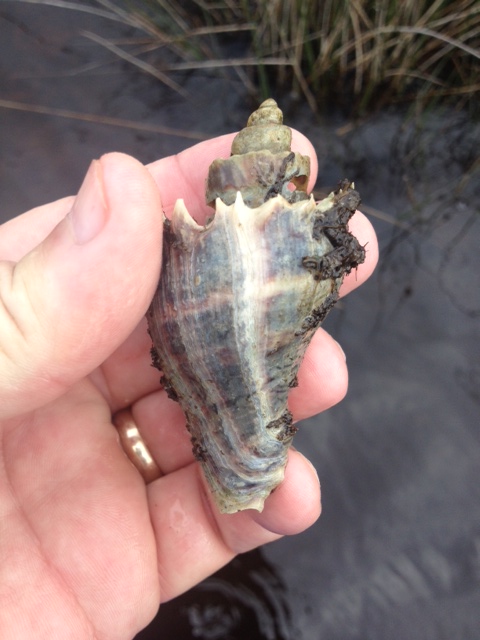
by Rick O'Connor | May 25, 2018
In recent weeks, volunteers and I have been surveying local estuaries counting terrapins, horseshoe crabs, and monitoring seagrass. One animal that has been very visible during these surveys is the relatively large snail known as the crown conch (Melongena corona). Its shell is often found with a striped hermit crab living within, but it is actually produced by a fleshy snail, who is a predator to those slow enough for it to catch.
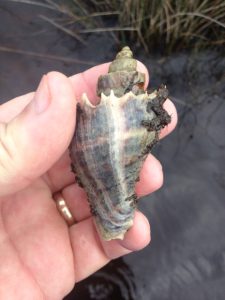
The white spines along the whorl give this snail its common name – crown conch.
Photo: Rick O’Connor
The shell is familiar to most who venture to the estuary side of our beaches. Reaching around five inches in length, crown conch shells are spiral with a wide aperture (opening) and brown to purple to white in color. Each whorl ends with white spins giving it the appearance of a crown and – hence – it’s common name. They are typically seen cruising along the sediments near grassbeds, salt marshes and oyster reefs – their long black siphons extended drawing in seawater for oxygen, but also to detect scents that will lead them to food.
These snails breed from winter to early summer. Females, larger than males, will develop 15-500 eggs in capsules, which they attach to hard structures within the habitat; such as wood, seagrass blades, and shell material.
Crown conchs are subtropical species and have a low tolerance for cold water. They are common in the panhandle and may expand further north along the Atlantic coast if warming trends continue. They have a higher tolerance for changes in salinity and can tolerate salinity as low as 8 ppt. The salinities within Pensacola Bay can be as low as 10 ppt and Santa Rosa Sound / Big Lagoon are typically between 20-30 ppt. The developing young require higher salinities and thus breeding takes in the lower portions of our estuaries.
These are guys are snail predators – seeking prey slow enough for them to catch. Common targets include the bivalves such as oysters and clams, but they are known to seek out other snails – like whelks. Crown conchs are known to feed on dead organisms they encounter and may be cannibalistic. As with all creatures, they have their predators as well. The large thick shell protects them from most but other snails, such as whelks and murex, are known predators of the crown conch.
These conchs tend to stay closer to shallow water (less than 3 ft.) due the large number of predators at depth. They are common in seagrass meadows and salt marshes and – if in high numbers with few competitors – have been considered an indicator of poor water quality. There is no economic market for them but they are monitored due to the fact they affect the populations of commercially important oysters and clams.
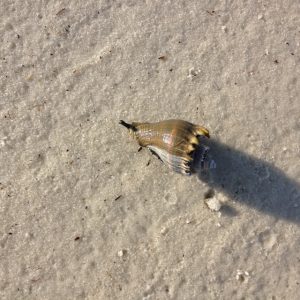
The “snorkel” is called a siphon and is used by the snail to draw water into the mantle cavity. Here it can extract oxygen and detect the scent of prey.
Photo: Franklin County Extension
It is an interesting animal, a sort of “jaws” of the snail world, and a possible candidate for a citizen science water quality monitoring project. Enjoy exploring your coastal estuaries this summer and discover some of these interesting animals.
Reference
Masterson, J. 2008. Indian River Lagoon Species Inventory: Crown Conch Melongena corona. Smithsonian Marine Station at Ft. Pierce, Florida. http://www.sms.si.edu/irlspec/Melongena_corona.htm.
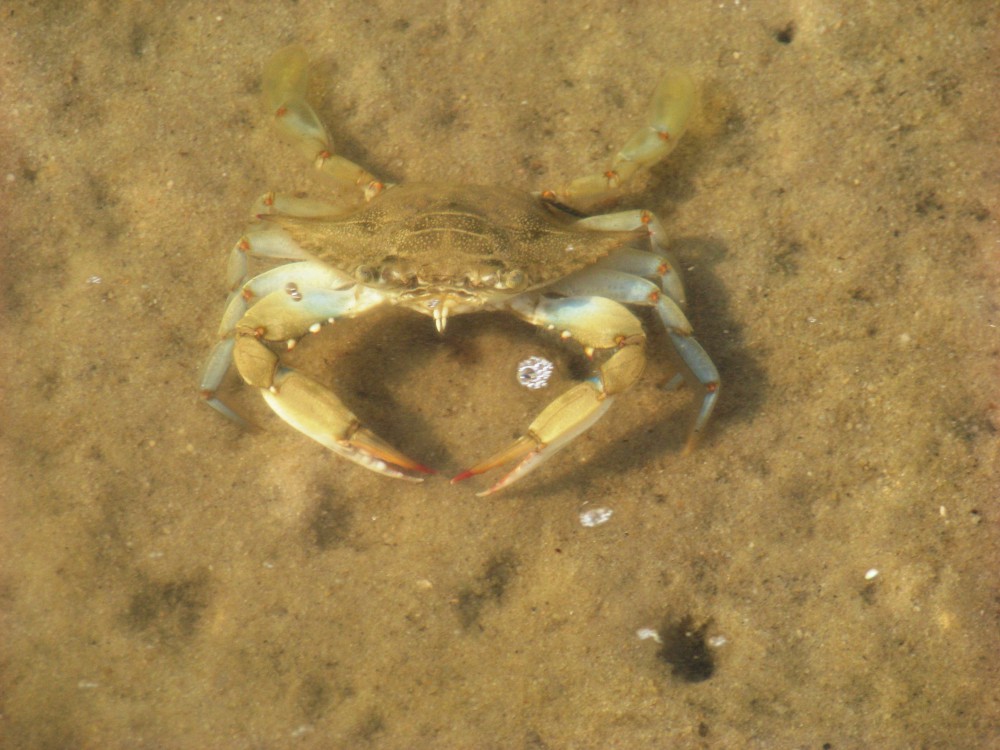
by Rick O'Connor | May 12, 2018
Records of the variety of aquatic life in Pensacola Bay go back to the 18th century. According to these reports, over 1400 species of plants and animals call Pensacola Bay home. Many of them depend on seagrass, oyster reefs, or marshes to complete their life cycle. The greatest diversity and abundance are found on the oyster reefs. Finfish and shellfish in the bay have sustained humans as a food source for centuries. However, we know that the alligator, turtles, and a variety of birds and mammals have also been important. In this article, we will focus on the aquatic species.

Red Drum – photo credit Florida Fish and Wildlife
When people think of aquatic life in the bay, they first think of fish. About 200 species call Pensacola Bay home. The most abundant are the true estuarine fish, such as croakers, sardines, and minnows. There are a variety of marine transient fish that can be found such as jacks, mackerels, and some species of sharks. Spot and Atlantic Croaker are the most abundant members of the croaker family, and are still an important target fish for locals. Anyone who has snorkeled or cast a line with cut bait knows how common pinfish can be, and those who have pulled bait nets are very familiar with the silverside minnows and anchovies.
I have pulled many a seine net over the years assessing the diversity and abundance of the nearshore fish populations and logged 101 species. In addition to those listed above, killifish (also locally known as “bull minnows”) are a common capture. For a few years, we were involved in trawling in deeper waters where we collected a variety of flounder, silver perch, grunts and snapper. Sea robins are an interesting member of our community and gag grouper were captured occasionally. The number and variety of fish found varies with seasons and is greatest in June. The diversity and abundance of estuarine fishes in our bay is very similar to neighboring estuaries.
The second thing people think of when they think of aquatic life in the bay are shellfish. These would include the crabs, shrimp, and oysters. However, the most abundant macro-invertebrates in our bay are those that can tolerate environmental stress and live in the surface layers of the sediments – these are the worms and crustaceans. There are numerous varieties of segmented polychaete worms, who are famous for building tunnels with “volcano” openings. They are also common within oyster reefs, feeding on all sorts of organic debris. Blue crab are common throughout the bay and provided both a commercial and recreational fishery for years. Brown and white shrimp are both found and have been the most popular seafood with locals for years.
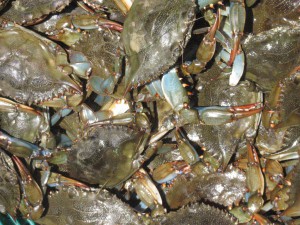
The famous blue crab.
Photo: FWC
During my lifetime, the only marine mammal commonly seen has been the Atlantic Bottlenose Dolphin, and these are found in many parts of the bay. Years back, I heard accounts of harbor porpoise, but never actually saw one. An historic occurring marine mammal, who seems to be making a comeback, is the Florida Manatee. Sightings of this animal have been reported in a variety of locations in recent years.
Snakes, turtles, and alligators are all found in the bay area. There is really only one saline snake and this is the gulf coast salt marsh snake. However, nontraditional estuarine snakes, such as the cottonmouth, are becoming more common in and near the bay. Though we have a great variety of turtles in our rivers, only one true estuarine turtle exist in the country, the diamondback terrapin – and this turtle can be found in parts of our bay. Sea turtles do venture into the bay searching for food, particularly the green turtle who is fond of seagrasses.
Many forget the small planktonic animals that drift in the water column, but they are there – about 100 species of them. Copepods are small roach looking crustaceans that are by far the most abundant member of the zooplankton, particularly the species known as Acartia tonsa – which makes up 82% of the abundance in our bay. These small animals are an important link in the food chain of almost every other member of the bay community. The zooplankton variety in Pensacola Bay is very similar to those of neighboring estuaries.
And then there are the plants…
By far, the most diverse group of organisms in the bay are the microscopic plants known as phytoplankton – with over 400 species reported. Much of the bay is too deep to support traditional forms of plants and so these become a key producer of food for many species. The diversity and abundance is greatest in the spring and fall. 70% of the phytoplankton are from a group called dinoflagellates, small plants that have two hair-like flagella to orient, and even propel, themselves. Some of them produce the bioluminescence we sometimes see and others produce what we call red tide. During the summer, the populations change and the more abundant forms are diatoms. These lack the flagella of the dinoflagellates, but they do produce beautiful shells of silica.
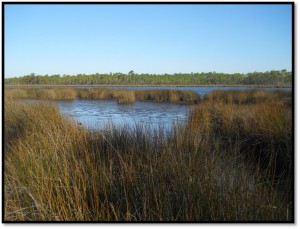
There are at least 400 species of periphytic algae (attaching). Green algae are the most abundant and are most common in the local bayous. Cyanobacteria, which were once thought to be algae, are the most abundant in the marshes and periphytic diatoms dominate in the Sound.
And last, are the submergent and emergent grasses.
Submergent grasses are known as seagrasses. We have three species that like the higher saline waters. These are turtle, shoal, and widgeon grass. Turtle and shoal grass need the water to be at least 25 parts per thousand and are the dominate species in the lower portions of the bay. Widgeon grass can tolerate waters as low as 10 ppt and are found in the bayous and the upper portions of the bay system. Tapegrass only survives in freshwater and are found in the lower reaches of the rivers where they meet the bay.
Emergent grasses are what we call marsh grasses. Two species, Black Needlerush and Smooth Cordgrass dominate these. There are pockets of salt marshes found all over the bay system.
So how is the health of our aquatic life?
As you might expect, the diversity and abundance have declined over time, particularly since the 1950’s. One firsthand account of the change, describe a bayou that was clear, full of grass, and harbored shrimp the size of your hand. Then they were gone. He remembered the first change being water clarity. As development along our waterfront increased, the clarity decreased and the aquatic life declined. This has happened all over the bay system. Increase in run-off not only brought sand and sediment lowering water clarity, it also brought chemicals that both the plants and animals could not tolerate. Much of the point source pollution has been controlled but non-point pollution is still problematic. Fertilizers, pesticides and herbicides, oils and grease, and sediment have all been problematic. These can be reduced. Following recommendations from the Florida Friendly Landscaping website, (http://www.deactivated_site/.) property owners can alter how they are currently managing their landscape to reduce their impact on the aquatic life on the bay. Clean Marina (https://floridadep.gov/fco/clean-marina ) and Clean Boater (https://floridadep.gov/fco/cva/content/clean-boater-program ) recommendations can help reduce the impact from the boating community. Sustainable fishing practices, such as safe catch and release methods for unwanted fish and removing all monofilament are good practices. In 2019, Sea Grant will begin a program training local citizens how to monitor the diversity and abundance of aquatic species. If interested in volunteering, stay tuned.
Reference
Lewis, M.J., J.T. Kirschenfeld, T. Goodhart. 2016. Environmental Quality of the Pensacola Bay System: Retrospective Review for Future Resource Management and Rehabilitation. U.S. Environmental Protection Agency. Gulf Breeze FL. EPA/600/R-16/169.
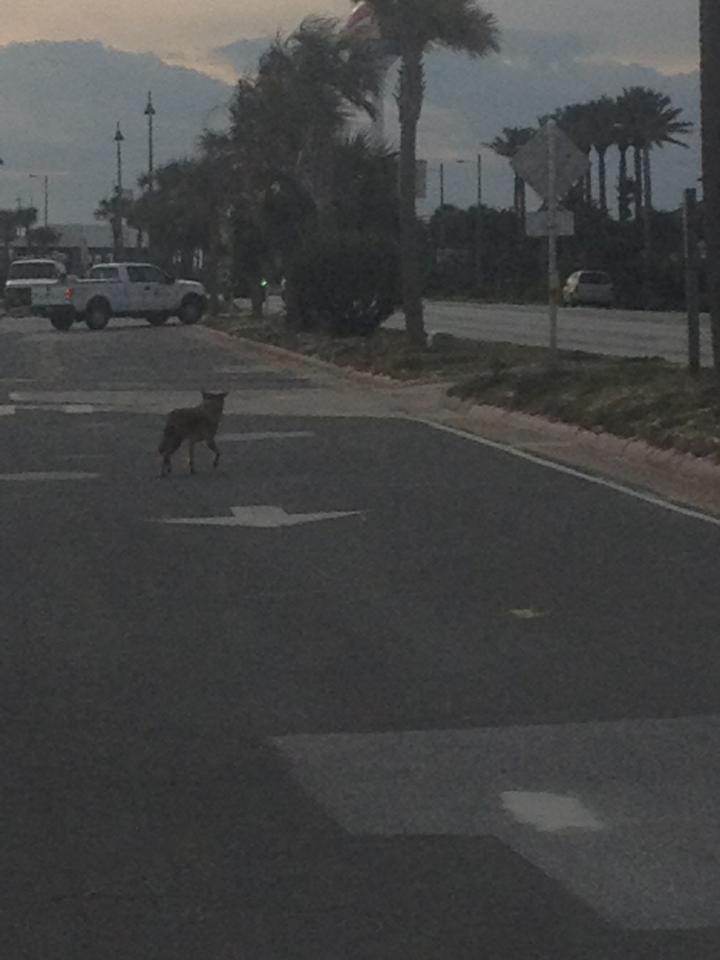
by Rick O'Connor | Apr 14, 2018
In my job, I get many calls about snakes. Most people want to know how to tell a venomous from a nonvenomous one and how to keep them out of the yard. I was recently reading a new book out by Dr. Sean Graham entitled American Snakes and in the chapter on snake defenses, he provided a long litany of local creatures who consumed snakes – some surprised me. Check this out…
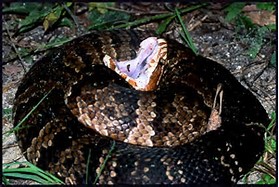
The “cottonmouth” gape of this venomous snakes is a warning. Notice the banded coloration of this individual.
Photo: UF IFAS Wildlife
First, most who do only consume smaller species of snakes – but the list is still surprising. Spiders… spiders were on the list. He specifically called out the black widow – who probably could kill a small snake, but indicated there were others. Scorpions, centipedes, fire ants, carpenter ants, giant water bugs, crayfish, and crabs made the list as well. Some of these may consume snakes only after they are dead – but some can kill small ones.
From the vertebrate world he mentions the larger salamanders (such as the hellbender), and other snakes (such as the short-tailed snake and the coral snake). There are several mammals including shrews, moles, and even the rodents themselves are consumers of snakes! He describes how hoofed mammals (such deer, goat, and horses) do not consume snakes, but can completely destroy one by raising and stopping on them – leaving only small segments remaining. They have found the remains of snakes in the stomachs of all predatory mammals but the snake’s greatest threat are birds… by a long shot. Species from passerines to raptors have been known to kill and consume snakes.
What about venomous snakes – who consumes rattlesnakes and cottonmouths?
There are surprises here as well…
Bullfrogs… bullfrogs basically consume what they can get into their mouths but this includes snakes – and venomous ones as well (though they would be small ones). From the fish world, both the gar and largemouth bass are known to consume venomous snakes.
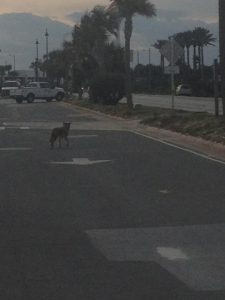
A coyote moving on Pensacola Beach near dawn.
Photo provided by Shelley Johnson.
Opossums are known to consume at least 12 species of snakes, including venomous ones. They also consume ticks, fire ants, and have a very low occurrence of rabies – a cool animal to have around.
Other mammal consumers of venomous snakes include raccoons, otters, fox, bobcats, coyotes, and black bears. It is understood they must take smaller members of the venomous snake population – but a snake control is snake control.
Most wading birds in our marshes consume snakes, including venomous ones, but it is the red-tailed hawk and the great horned owl that are the masters. Red-tailed hawks are known to consume at least 35 species of snakes, including venomous ones, and – unlike other snake predators – are a larger part of their diet, they seek them out. Great Horned Owls consume at least 13 species, and venomous ones are on the menu.
From the reptile world we begin with the alligator, who has little problem consuming large specimens of both the rattlesnake and the cottonmouth. However, many are snakes… yes, snakes eat snakes and some consume venomous ones. Coral snakes, coachwhips, and cottonmouths have been known to consume other snakes. However, it is the Eastern Indigo and the Kingsnakes who actively seek out venomous species. It is known that kingsnakes have a protein in their blood that makes them immune to the viper’s venoms – and it appears the vipers know this and avoid them. It is not known whether the indigo is immune, but it is known they will seek out venomous snakes and consume. Both of these snakes can take relatively large venomous species.
Of these two, it is the Kingsnake who is the “king” – consuming at least 40 species of snakes. However, both the kingsnakes and the indigo are on the declined. The eastern indigo is currently federally listed as endangered – there has not been a verified record of one in the Florida panhandle since 1997. However, there are anecdotal reports and we encourage anyone who has seen one to send us a photograph. There is an active indigo restoration program going on in Alabama and in the Apalachicola River area. These are the largest native snakes in the U.S. (about 8 feet) and, along with the six-foot kingsnakes, are frequently killed. There is evidence that as the eastern kingsnake populations decline copperhead populations increase, and Vis versa. Some areas near Atlanta are currently experiencing a copperhead “boom”. Clearly, we should reconsider killing both the indigo and kingsnakes. We also understand that habitat loss is another cause of their decline, particularly in the case of the indigo.
When looking at this list of snake consumers we see species that cause other problems – alligators, raccoons, coyotes, and bears have all have had their negative issues. But many we just do not like, such as the opossum, really cause us no harm and control snake populations. Everything has its place in the local environment and not one species seeks out humans for the purpose of harming us – this would include snakes. The negative encounters are for other reasons. But for those who have a deep fear, or are currently experiencing high snake numbers, seeing one of the animals on this in the neighborhood could be a relief.
References
Graham, S. 2018. American Snakes. John Hopkins University Press. Baltimore MD. Pp 293.
O’Connor, M. 2018. Personal communication.
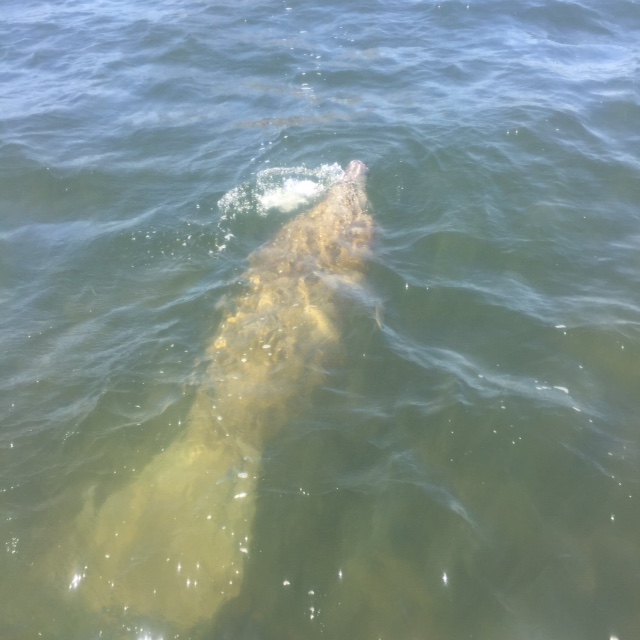
by Rick O'Connor | Feb 16, 2018
As a young boy growing up here in the panhandle, I had heard of this thing called a manatee – but had never seen one. They came more into the light when I was a teenager and becoming interested in marine biology. I was the president of the high school marine biology club and one of our goals was to raise money for a trip to Crystal River to snorkel with them. The Save the Manatee Club originated in that time trying to bring more awareness to the plight of this endangered Floridian and at one point, Jimmy Buffett had led the way.
I had learned a lot about them, found out their original range was from North Carolina south to the Caribbean and the entire Gulf of Mexico, but were now down to about 1000 animals and those were found in Florida. Eventually I did get to see manatees, and have snorkeled with them many times, but still thought of them as a south Florida animal – rarely found in the panhandle.
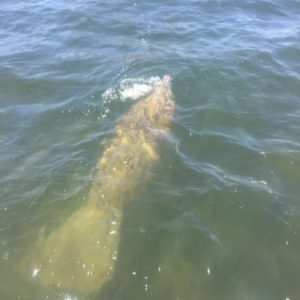
Manatee swimming in Big Lagoon near Pensacola.
Photo: Marsha Stanton
Then the recent news report – two dead manatees in the last two weeks. One washed ashore in Okaloosa county and the other in Escambia. Probably victims of the recent cold fronts. It is not unheard of finding manatees in the panhandle in recent years. I recall since the 1990’s a manatee seen in Bayou Texar in Pensacola. In another year, one was seen near Ft. Pickens. My son worked at a local marina and saw at least one a year there. There have been so many seen in the Mobile Bay area that Dauphin Island Sea Lab now has a Manatee Watch program. There are about 40 individuals that now visit Wakulla Springs. In addition, this summer there were two separate groups living in the Pensacola area. One group was residing near Gulf Breeze and a second group of about eight animals was frequently seen near Perdido Key. These once rare animals in the panhandle are now being found each year, and sometimes in groups.
What is going on?
Why are manatees beginning to visit our area?
Your first hunch would be climate change. Manatees are marine mammals but unlike their dolphin cousins their blubber layer is not as thick and they must seek warm water refuge during the winter months. When water temperatures drop below 67°F, they locate the warm water springs found in central Florida – or move south Florida where the water remains comfortable year round. If they are remaining here, could the average water temperatures have warmed enough for them to make this move?
Along this same line, mangroves are now being found in the panhandle. Both red and black mangroves have been found growing in local estuaries. In the Apalachicola area there have been quite a few located. In the western panhandle there a few individuals here and there. Further west they are found on the islands of Mississippi and have been in the Chandeleurs for many years now. Later this spring Florida Sea Grant will be conducting surveys in each county to see where these tropical trees may be growing.
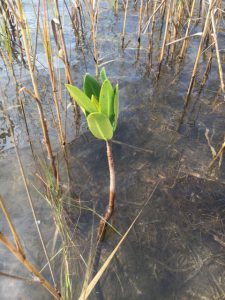
A small red mangrove growing in Big Lagoon near Pensacola FL
Photo: Rick O’Connor
And most recently are sightings of snook, a south Florida fish that have, though rare, been seen in the northern Gulf of Mexico. No doubt this Januarys hard freezes probably killed the mangroves that were here, and probably the two manatees washed ashore recently, but it will be an interesting time to see what other tropical species begin their slow migration northward. If it does happen, what will that mean? How will these changes impact local ecosystems? At this point, I am not sure if it will happen or, if it does, how fast – but it will be interesting.


















